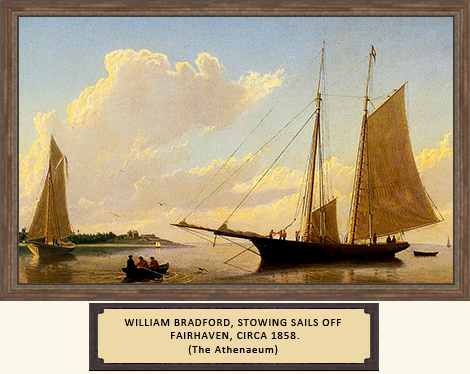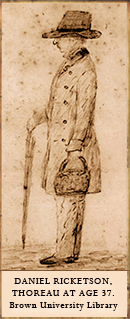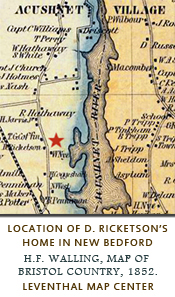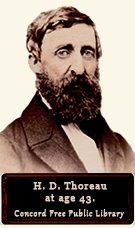
Visit the New Bedford Whaling Museum. Visit the Rotch-Jones-Duff House and Garden Museum. (Architectural drawing available at the Metropolitan Museum of Art) Explore the New Bedford Museum of Glass. See what's happening at the New Bedford Art Museum. Learn more at the New Bedford Whaling National Historical Park. |
New BedfordAlthough Thoreau lectured only once in New Bedford, he traveled here relatively frequently to visit his close friend Daniel Ricketson. The two met in December 1854 after Ricketson wrote to say how much he had enjoyed reading Walden. Thoreau was slow to respond at first, but after he recognized their mutual interest in natural history, philosophy, and poetry, he agreed to come to Brooklawn, Ricketson's home in New Bedford, on his way to give a talk in Nantucket. One of the many reasons why Ricketson took such an immediate liking to Walden, which was, no doubt, also a factor in the unusually close relationship the two developed, was that Ricketson had several years earlier built what he called his "Shanty." This hut stood a short distance from his house at Brooklawn and, even though it was a bit less remote than Thoreau's cabin, it served a similar purpose as a place for reflection, writing, and watching the progress of the seasons. While Thoreau later wrote an extensive description of the Shanty in his journal, Ricketson detailed his visitor's appearance in words and in an informal sketch that recorded how Thoreau looked when he arrived at Brooklawn on Christmas Day: In the latter part of the afternoon...I saw a man walking up the carriage road, bearing a portmanteau in one hand and an umbrella in the other. He was dressed in a long overcoat of dark cloth and wore a dark soft hat...It flashed at once in my mind that the person before me was my correspondent, whom in my imagination I had figured as stout and robust, instead of the small and rather inferior looking man before me...The most expressive feature of his face was his eye, blue in color and full of the greatest humanity and intelligence... In Thoreau, as in other heroic men, it was the spirit more than the temple in which it dwelt, that made the man." On his subsequent visits to New Bedford, Thoreau studied the area extensively, following in this case, as in many others, the model of Samuel Champlain,whose work he admired, as he wrote Cape Cod, because it included such a broad array of "information, geographical, ethnographical, zoological, and botanical." With his usual determination to seek out whomever might be most interesting everywhere he went, he walked from Ricketson's to Fairhaven to visit the studio of William Bradford, later recognized as one of the world's most accomplished marine painters. As it turned out, Bradford was away, but Thoreau did meet Dutch artist Albert Van Beest, Bradford's mentor, who was at that time more well known than his soon-to-be famous student. Ricketson also visited Thoreau in Concord, stopping there sometimes after attending anti-slavery meetings in Boston. A committed Quaker, Ricketson never promoted any violent action even to end slavery, but he carried on the progressive tradition of New Bedford by arranging anti-slavery lectures at the local lyceum and writing for the Liberator, along with other anti-slavery journals. He also wrote a history of the town that included a detailed chapter on the "Early and Continued Anti-Slavery Character of New Bedford," in which he proudly summarized the local devotion to principles of equality by recalling that the "passage of the odious "Fugitive Slave Bill" was received here...with an almost universal contempt; and it is thought that the rendition of a fugitive from our city could not be effected."
On his final trip to New Bedford in August 1861, Thoreau allowed Ricketson to prevail on him to have his picture taken by Albert Dunshee, an accomplished artist who created two ambrotypes from the sitting. There is still some confusion about exactly how many images of Thoreau were made during his lifetime, but his family seems to have preferred the Dunshee portrait. After Thoreau's death on May 6, 1862, his sister, Sophia Thoreau, upon receiving one of the Dunshee ambrotypes from Ricketson wrote in reply: "Until a few weeks since I did not know that Henry had his picture taken when in New Bedford last; he accidentally spoke of it, and said that you considered it a good likeness. None of his daguerreotypes have pleased us, and I did not imagine that the ambrotype would afford us much satisfaction...I need not tell you, for I cannot, how agreeably surprised I was on opening the little box, to find my own lost brother again. I could not restrain my tears. I discover a slight shade about the eyes expressive of weariness, but a stranger might not observe it. I am very glad to possess a picture of so late a date...Mr. Channing, Emerson, Alcott, and many other friends who have looked at the ambrotype express much satisfaction." |














